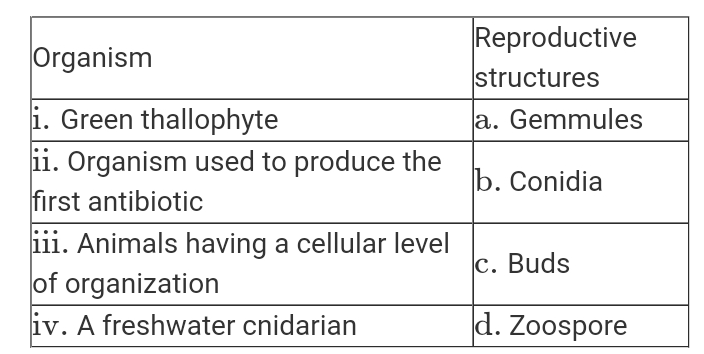The organisms that are structurally less complex undergo _____ reproduction.
Step-by-Step Text Solution:
1. Understanding the Question: The question asks about the type of reproduction that occurs in organisms that are structurally less complex.
2. Identifying Organisms: Organisms that are structurally less complex are typically found in lower taxonomic groups, such as unicellular organisms and simple multicellular organisms.
3. Types of Reproduction: There are two main types of reproduction: sexual and asexual. Asexual reproduction involves only one parent and does not require the fusion of gametes.
4. Asexual Reproduction: In asexual reproduction, the offspring are genetically identical to the parent organism. This type of reproduction can occur through various methods such as:
- Budding: A new organism develops from an outgrowth or bud on the parent.
- Fragmentation: The parent organism breaks into fragments, each capable of growing into a new organism.
- Binary Fission: The parent organism divides into two equal parts, each becoming a new organism.
5. Conclusion: Given that structurally less complex organisms typically reproduce asexually, the answer to the question is: "The organisms that are structurally less complex undergo asexual reproduction."
---
- Budding: A new organism develops from an outgrowth or bud on the parent.
- Fragmentation: The parent organism breaks into fragments, each capable of growing into a new organism.
- Binary Fission: The parent organism divides into two equal parts, each becoming a new organism.
Topper's Solved these Questions
- REPRODUCTION IN LOWER ORGANISMS AND PLANTSBOOK - PEARSON IIT JEE FOUNDATIONCHAPTER - REPRODUCTION IN LOWER ORGANISMS AND PLANTSEXERCISE - TEST YOUR CONCEPTS (SELECT THE CORRECT ALTERNATIVES)
22 Videos
- REPRODUCTION IN LOWER ORGANISMS AND PLANTSBOOK - PEARSON IIT JEE FOUNDATIONCHAPTER - REPRODUCTION IN LOWER ORGANISMS AND PLANTSEXERCISE - MASTERING THE CONCEPTS (KNOWLEDGE AND UNDERSTANDING)
29 Videos
- REPRODUCTION IN LOWER ORGANISMS AND PLANTSBOOK - PEARSON IIT JEE FOUNDATIONCHAPTER - REPRODUCTION IN LOWER ORGANISMS AND PLANTSEXERCISE - ASSESSMENT TESTS (ANSWER THE FOLLOWING QUESTIONS)
11 Videos
- REPRODUCTION IN HUMAN BEINGSBOOK - PEARSON IIT JEE FOUNDATIONCHAPTER - REPRODUCTION IN HUMAN BEINGSEXERCISE - ASSESSMENT TESTS
35 Videos
Similar Questions
Name the male and female reproductive organ.
View SolutionAssertion : External parasitism is generally marked by much more exterme specialisation than internal parasitism.
Reason : The structure of an internal parasite is usually very complex possessing suckers, reproductive organs, etc.
View Solution
Knowledge Check
In animals and other simple organisms uniparental reproduction is called _______ reproduction.
Avegetative, asexualBAsexual, vegetativeCParthenogenetic, AmphimicticDAmphimictic, ApomicticMolluscs undergo....type of reproduction .
AasexualBsexualCBoth (a) and (b)DNone of theseMatch the following organisms with their respective structures used for reproduction and choose the correct option.
 Ai−c,ii−d,iii−a,iv−bBi−d,ii−a,iii−b,iv−cCi−b,ii−c,iii−d,iv−aDi−d,ii−b,iii−a,iv−c
Ai−c,ii−d,iii−a,iv−bBi−d,ii−a,iii−b,iv−cCi−b,ii−c,iii−d,iv−aDi−d,ii−b,iii−a,iv−c
Structure Of Complex
View SolutionName the female reproductive organ.
View SolutionThe uniparental reproduction is called ______ reproduction while biparental reproduction is termed _____ reproduction. Higher organisms mostly show______ reproduction.
View SolutionSporocarp is a reproductive structure of
View SolutionSporocarp is a reproductive structure of
View Solution
